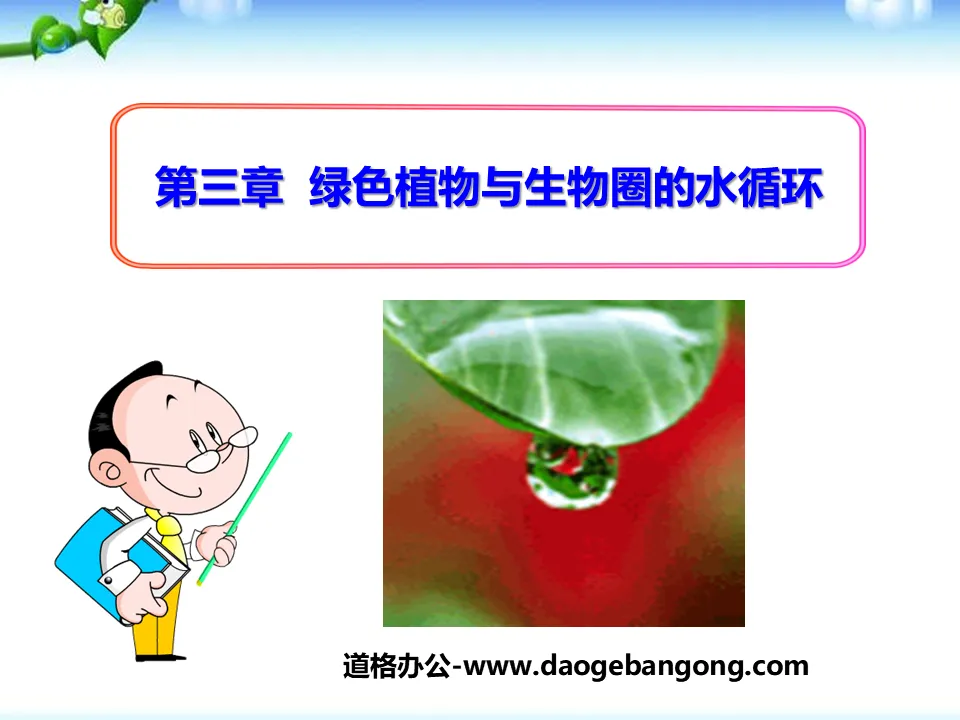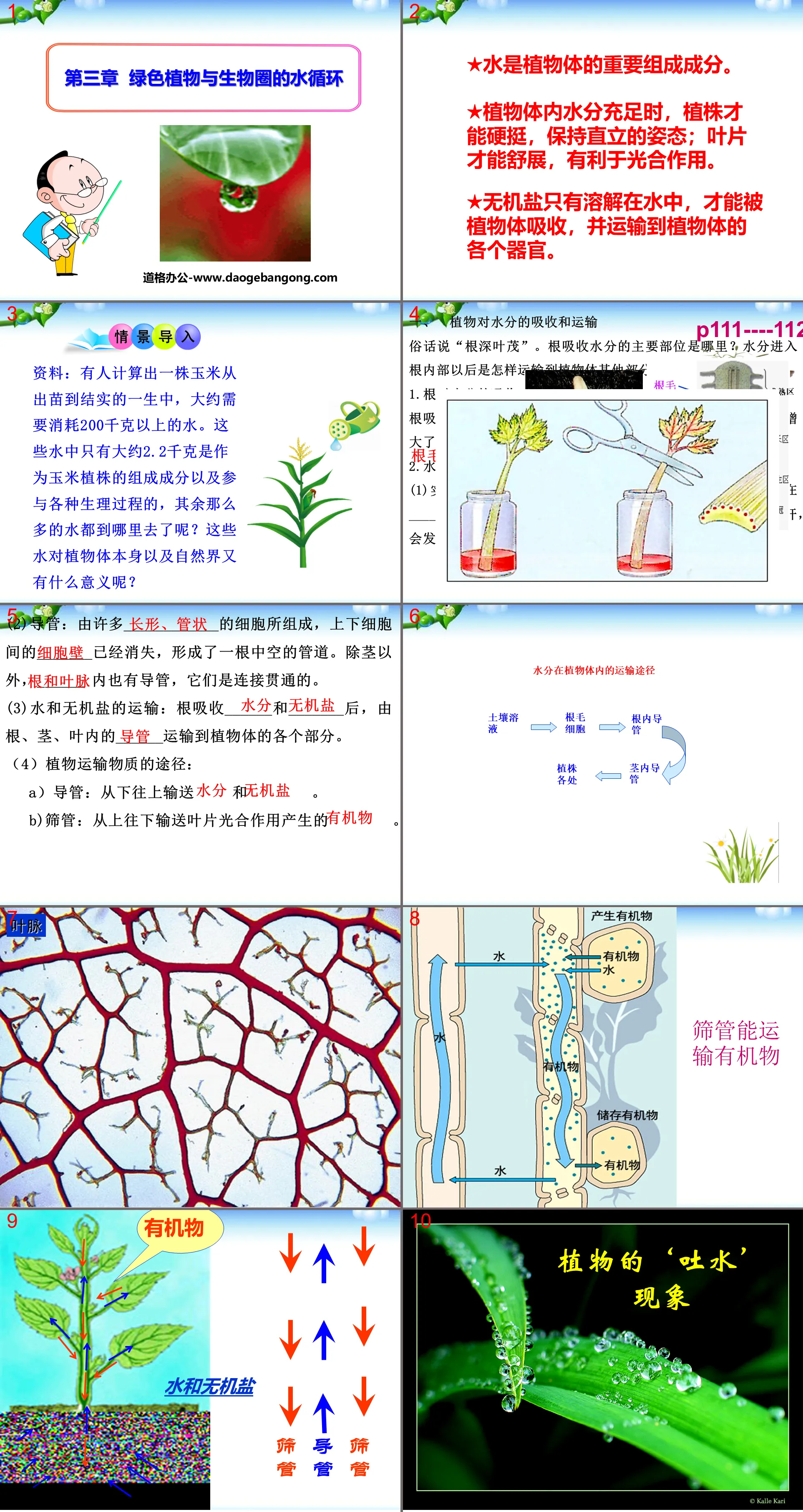People's Education Edition Biology for Grade 8, Volume 1
People's Education Edition seventh grade biology volume 1
People's Education Edition Biology for Grade 8, Volume 2
Beijing Normal University Edition Seventh Grade Biology Volume 2
People's Education Press High School Biology Compulsory Course 2
People's Education Press seventh grade biology book volume 2
Beijing Normal University Edition Eighth Grade Biology Volume 2
Beijing Normal University Edition Seventh Grade Biology Volume 1
Beijing Normal University Edition Eighth Grade Biology Volume 1
High School Biology Compulsory Course 1, published by People's Education Press
Jiangsu Education Edition Seventh Grade Biology Volume 1
Jiangsu Education Edition 8th Grade Biology Volume 1
Jiangsu Education Edition Seventh Grade Biology Volume 2
Jiangsu Education Edition 8th Grade Biology Volume 2

| Category | Format | Size |
|---|---|---|
| People's Education Edition seventh grade biology volume 1 | pptx | 6 MB |
Description
"Green Plants and the Water Cycle of the Biosphere" PPT Courseware 2
Water is an important component of plants.
When there is sufficient water in the plant, the plant can be stiff and maintain an upright posture; the leaves can stretch, which is conducive to photosynthesis.
Only when inorganic salts are dissolved in water can they be absorbed by the plant body and transported to various organs of the plant body.
Situation import
Information: Someone calculated that a corn plant consumes more than 200 kilograms of water during its lifetime from emergence to fruiting. Only about 2.2 kilograms of this water is used as a component of the corn plant and participates in various physiological processes. Where did the rest of the water go? What significance does this water have to the plants themselves and the natural world?
1. Plants’ absorption and transportation of water
As the saying goes, "the roots are deep and the leaves are flourishing." Where is the main part of the root that absorbs water? How is water transported to other parts of the plant after entering the root?
1. Root absorption of water
The main part of the root that absorbs water: the _______ at the root tip. There is a large amount of _____ growing there, which increases the ______ for the roots to absorb water.
2. Transport of moisture
(1) Experiment: Take a section of _____ stem, put it into water with a few drops of red ink, and irradiate it under ______ for 3 to 4 hours. You will see ______ turn red; cut the stem lengthwise If you turn it on, you will find that ______ turns red.
(2) Duct: It is composed of many ____________ cells. The _______ between the upper and lower cells has disappeared, forming a hollow tube. In addition to the stem, there are also ducts in the ______, which are connected through each other.
(3) Transportation of water and inorganic salts: After roots absorb ______ and _______, they are transported to various parts of the plant through ______ in roots, stems, and leaves.
(4) Pathways for plants to transport substances:
a) Catheter: carries _____ and _____ from bottom to top.
b) Sieve tube: transports _____ produced by photosynthesis of leaves from top to bottom.
Observe the structure of the leaves
What is the main organ through which plants lose water? What is its structure?
1. Practice slicing with your hands and make temporary slices of cross-sections of leaves.
(1)Put the fresh leaves ______ on the small wooden board.
(2) Pinch the side-by-side __________ with your right hand and quickly cut across the leaves.
(3) Every time you make a cut, dip the blade in water and put the cut ______ into the water.
(4) Use a brush to dip a piece of ______ into it to make __________.
2. Blade structure
epidermis
upper epidermis
lower epidermis
There are stomata (more stomata in the lower epidermis)
Mesophyll: vegetative tissue. There are chloroplasts in the mesophyll cells. Their main function is to carry out _______.
Leaf veins: have vessels and sieve tubes, belong to ________, and have transport and support functions.
Stomata is the "portal" through which plants lose water through transpiration and is also the "window" for gas exchange.
ANALYSE information
1. According to scientific calculations, the rainfall in a certain tropical rainforest is 1,950 mm/year, and the transpiration is 1,570 mm/year. Please calculate, what percentage of the rainfall does transpiration account for?
2. As the saying goes: "It's good to enjoy the shade under a big tree."
According to the survey, on a scorching summer day, the temperature in green areas is 0.8°C lower than that in non-green areas, and the temperature in the forest is 1.3°C to 3.2°C lower than the temperature in the courtyard.
What conclusion can you draw from these two pieces of information?
Plant transpiration not only promotes the absorption and upward transport of water and inorganic salts by plants, but also reduces the temperature of plants.
Transpiration can also increase atmospheric humidity, increase precipitation, and participate in the water cycle of the biosphere.
【Cooperation and exchange】
1. When transplanting saplings, flower seedlings and vegetables, why are there lumps of soil at the roots?
Protect root hairs and young roots and improve plant survival rate.
2. Are duct cells living cells? Why?
Ducts are tubes formed by many long, tubular cells with the cell walls disappearing between them. There is no cytoplasm or nucleus, so duct cells are dead cells.
3. Why do we need to cut the leaves into slices before we can observe their structure?
The material to be observed with a microscope must be thin and transparent. The leaves are opaque and cannot be observed. Thin and transparent slices must be made for observation.
4. Functionally speaking, what tissues do the ducts and sieve tubes in the epidermis, mesophyll and leaf veins belong to?
The epidermis is a protective tissue, the mesophyll is a nutritional tissue, and the ducts and sieve tubes in the leaf veins are conductive tissues.
5. In the leaves of land plants, do the upper epidermis and lower epidermis have the same number of stomata? Why?
The lower epidermis of land plants has many stomata, which can reduce water loss.
Keywords: Green Plants and the Biosphere's Water Cycle Teaching Courseware, People's Education Edition 7th Grade Biology PPT Courseware Download, Seventh Grade Biology Slide Courseware Download, Green Plants and the Biosphere's Water Cycle PPT Courseware Download, .PPT format;
For more information about the "Water Cycle of Green Plants and Biosphere" PPT courseware, please click the "Water Cycle of Green Plants and Biosphere" ppt tag.
"Green Plants and the Water Cycle of the Biosphere" PPT courseware 7:
"Green Plants and the Water Cycle of the Biosphere" PPT Courseware 7 1. Plants' absorption and transportation of water Independent learning: There are white hairs on the young roots. What are the characteristics of root hairs? A large number of root hairs can increase the surface area for roots to absorb water and improve the root's ability to absorb water. Root absorption...
"Green Plants and the Water Cycle of the Biosphere" PPT courseware 6:
"Green Plants and the Water Cycle of the Biosphere" PPT courseware 6 1. Absorption and transportation of water by plants 1. Where do plants absorb water? 2. What is the transport pathway of water within the stem? 3. How is water transported within plants? Plants mainly absorb...
"Green Plants and the Water Cycle of the Biosphere" PPT courseware 5:
"Green Plants and the Water Cycle of the Biosphere" PPT Courseware 5 Learning Objectives: Describe the basic structure of green plant leaves. Explain the opening and closing mechanism of stomata. Explain the role of green plants in the water cycle of the biosphere. Plants absorb and transport water. There are white hairs on the young roots. ..
File Info
Update Time: 2024-11-13
This template belongs to biology courseware People's Education Edition seventh grade biology volume 1 industry PPT template
"Green Plants and the Water Cycle of the Biosphere" PPT Courseware 2 Simple campus recruitment activity planning plan summary enterprise and institution recruitment publicity lecture PPT template is a general PPT template for business post competition provided by the manuscript PPT, simple campus recruitment activity planning plan summary enterprise and institution recruitment promotion Lecture PPT template, you can edit and modify the text and pictures in the source file by downloading the source file. If you want more exquisite business PPT templates, you can come to grid resource. Doug resource PPT, massive PPT template slide material download, we only make high-quality PPT templates!
Tips: If you open the template and feel that it is not suitable for all your needs, you can search for related content "Green Plants and the Water Cycle of the Biosphere" PPT Courseware 2 is enough.
How to use the Windows system template
Directly decompress the file and use it with office or wps
How to use the Mac system template
Directly decompress the file and use it Office or wps can be used
Related reading
For more detailed PPT-related tutorials and font tutorials, you can view: Click to see
How to create a high-quality technological sense PPT? 4 ways to share the bottom of the box
Notice
Do not download in WeChat, Zhihu, QQ, built-in browsers, please use mobile browsers to download! If you are a mobile phone user, please download it on your computer!
1. The manuscript PPT is only for study and reference, please delete it 24 hours after downloading.
2. If the resource involves your legitimate rights and interests, delete it immediately.
3. Contact information: service@daogebangong.com
"Green Plants and the Water Cycle of the Biosphere" PPT Courseware 2, due to usage restrictions, it is only for personal study and reference use. For commercial use, please go to the relevant official website for authorization.
(Personal non-commercial use refers to the use of this font to complete the display of personal works, including but not limited to the design of personal papers, resumes, etc.)
Preview










